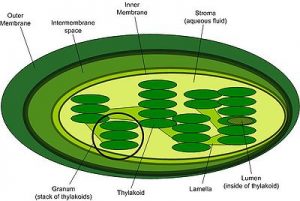 Scientists estimate that over 400 million-million horsepower of solar energy reaches the earth every day. Photosynthesis is the process by which sunlight is transformed into carbohydrates (the basis of all the food on our planet). This takes place in the chloroplasts. Each one is lens-shaped, something like an almost flat cone with the rounded part on the upper side. Sunlight enters from above.
Scientists estimate that over 400 million-million horsepower of solar energy reaches the earth every day. Photosynthesis is the process by which sunlight is transformed into carbohydrates (the basis of all the food on our planet). This takes place in the chloroplasts. Each one is lens-shaped, something like an almost flat cone with the rounded part on the upper side. Sunlight enters from above.
Inside the chloroplast are tiny cylinders, called lamelliae, that look something like the small circular batteries used in small electrical devices. Each cylinder is actually a stack of several disk-shaped thylakolds. Each thylakold is the shape of a coin. Several of these are stacked on top of each other, and this makes a single stack, or lamelium. A small narrow band connects each stack to another stack. They look like they are all wired like a bunch of batteries. Sunlight is processed by chlorophyll in those stacks, and is then stored (!) there as chemical energy in the form of sugar molecules. Chlorophyll, itself, is very complicated and never exists outside of the plant, just as DNA and ten thousand of other chemical structure never exist outside plants and/or animals.
If they are not found outside, how did they ever get inside?
In many plants, the tiny disks containing chlorophyll move about within plant cells and adjust for different light and heat conditions. When the sunlight is too strong the little disks turn edgewise. On an overcast day, they lie as parallel to the sky as they can in order to take in the most light. Do they have brains?
[used by permission from the Evolution Handbook – pg 240]


Leave a Reply